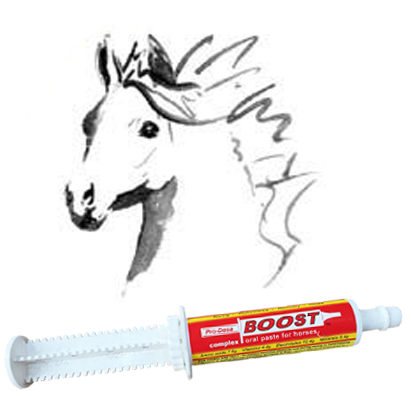Does It Have the Right Stuff and Is the Balance Right?
When reading labels, it is important to consider all aspects of the nutrient composition, including, completeness, balance, form, and dose. Then you can compare the composition to the nutrient requirements of your horse.
Completeness
Metabolism is quite complex, requiring a broad range of essential nutrients to function optimally. You can’t just feed two or three nutrients and hope to support performance, recovery, health, and metabolism. A lot of one nutrient doesn’t make up for deficiencies in another. If you ran out of food in your house and tried to just live on a big bag of salt, you wouldn’t last long.
Balance
The balance between nutrients is equally important. Some nutrients are required for the uptake and function of other nutrients. (These supportive and cooperative nutrients are called co-factors.) Too much or too little of one nutrient may result in deficiencies or toxicities of other nutrients. Imbalances, therefore, can adversely affect health, performance, and recovery. At a minimum, imbalances in a feed or supplement can render a product ineffective.
For instance, vitamin C is required for the absorption of iron from the gut. Without vitamin C, iron passes straight through the gut and out in the faeces. Vitamin E, on the other hand, has a negative interaction with iron. It binds with iron and reduces its absorption, causing much of it to be wasted. So, in order for horses to use dietary iron effectively, it must be administered with vitamin C and without vitamin E. Iron balance is also closely related to Zinc, Manganese, Cobalt, and Copper.
Common Feed Ratios
| NUTRIENTS | RATIO |
|---|---|
| Ca:P | 1-2:1 |
| Zn:Mn | 0.7-1.1 |
| Zn:Cu | 3-4:1 |
| Fe:Cu | 4:1 |
B vitamins are known to work better when administered in optimal balance with each other. They act in concert in many metabolic pathways important in energy production, red blood cell production, coat and skin condition, nerve cell function, and appetite. Giving a bigger dose of one B vitamin may not produce improvements in health or performance if the entire range of B vitamins is not supplied in optimal balance.
Amino acids are another good example of how nutrient balance is important. That is a topic I will discuss further in READING LABELS PART 4 – about evaluating feeds, but in the meanwhile, read the article written by Dr. J. Stewart that we posted on our blog about top-line. In that article, Jenny explains how the balance of amino acids in a feed is as important as the amount of protein. Imbalances in amino acids limit the amount of protein in a feed that is usable in the horse to produce proteins and muscle cells, and the wasted amino acids, that can’t be used for protein synthesis, create a load on kidneys, elevate body temperature, and elevate heart rates.
Bioavailability
Bioavailability refers to how absorbable and usable nutrients are. While this is partly related to the composition and balance of nutrients in a product, the term is most frequently applied to the form each nutrient is provided in.
Some forms are more easily absorbed and used than others. The trace element Chromium, for example, exists in several different forms. The form of chromium found in a chrome bumper on a car is not very digestible at all, but the form incorporated into yeasts is very easily absorbed and then used by cells. Minerals including Calcium, Magnesium, Iron, Cobalt, Copper, Zinc, Selenium, and Manganese can all be provided in a variety of forms, each of which have differences in their bioavailability. In general, inorganic forms of nutrients are less well used than organic forms, though that is not always a reliable rule. Zinc Oxide is one of the most bioavailable forms of Zinc, whereas Zinc Chelate forms a big molecule that remains quite inert. In most cases, though, minerals provided as gluconates, lactates, and amino acid or protein complexes are well used.
When reading labels, you should note whether the amount of the ingredient or the amount of the active molecule is listed. For instance, Iron Bioplex (iron is bound to amino acids or protein) contains only about 10% iron. If a label says a product contains 400mg of iron per dose, that would mean that a dose contains about 4000mg of Iron Bioplex yielding 400mg of very well absorbed and used iron. If the label says a product contains 400mg of Iron Bioplex per dose, then it really only has 40mg of iron. Make sure that you read those details carefully when reading labels and comparing products.
So that’s part 2 done!
To recap Reading Labels – Parts 1 and 2 on Supplements
From Part 1: If labels are easy to understand so that you can tell, at a glance, what you are giving your horse, then the manufacturer is probably proud of their formulation and believe it will stand up to scrutiny. If you have to perform too many calculations to figure out what you are giving, there is a fair chance that the formulation isn’t great. In any case, take the time to do the math and make sure you are comparing apples before picking the cheapest or prettiest product on the shelf.
From Part 2: When reading labels, it is important to consider all aspects of the nutrient composition, including balance, form, and dose, in relation to the nutrient requirements of your horse.
Make sure you read the third instalment of this Reading Labels Blog Reading Labels Part 3 – Product Quality Management. This looks at the quality of ingredients and manufacture.


